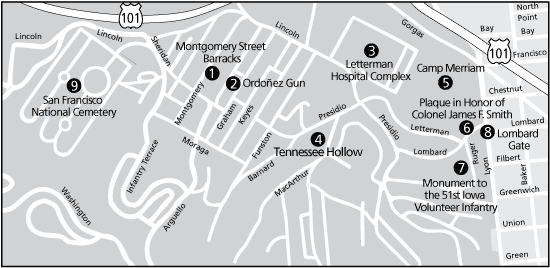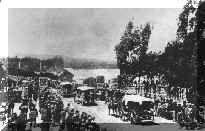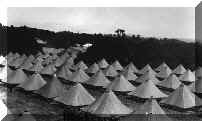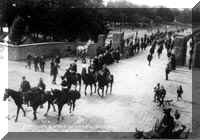Last updated: July 29, 2019
Article
Spanish American War - "A Splendid Little War"

On April 21, 1898, the United States declared war against Spain. It would be the first overseas conflict fought by the U.S. It involved major campaigns in both Cuba and the Philippine Islands.
The reasons for war were many, but there were two immediate ones: America's support the ongoing struggle by Cubans and Filipinos against Spanish rule, and the mysterious explosion of the battleship U.S.S. Maine in Havana Harbor.
Half a world away and only 11 days after the war began, the Spanish Pacific fleet in Manila Bay was defeated by the U.S. Navy in swift strike made by Commodore George Dewey. Unaware of Dewey’s quick success, President McKinley ordered troops to mount a campaign against the capital of Manila.
The military base best suited to stage this campaign was the Presidio of San Francisco. Volunteer soldiers from all over the United States gathered and trained at the Presidio before the long sea voyage to the Philippines.
Their quest was described as a "splendid little war" by Secretary of State John Hay.
The Presidio’s Role
The Presidio was a natural choice because it is next to the finest harbor on the West Coast. The post also had enough land to house and train large numbers of troops.
The first overseas units left the Presidio in May 1898. They were the 1st California Infantry and the 2nd Oregon Infantry Regiments. Soon volunteer units from Washington State, Montana, Iowa, Wyoming, Kansas, Tennessee and Utah would be stationed at the Presidio. From the beginning of the war to 1900, some 80,000 men passed through the post on their way to and from the Philippines.
At the turn of the century, San Francisco offered many attractions, but army life at the Presidio was cramped, and sickness often flared up in the temporary tent camps. This situation prompted the military to improve troop facilities and helped change the face of the Presidio over the ensuing years.
Fighting Continues in the Philippines
Philippine rebels had been waging guerrilla warfare against Spanish colonialism long before the U.S. became involved. Their exiled leader, Emilio Aquinaldo, communicated with the U.S. Army already on its way to the Philippines. He believed the United States would help the "Insurrectos" gain independence from Spain.
But the U-S government had another idea. After the signing the peace treaty with Spain in late 1898, the U.S. gave Cuba its independence but kept the Philippines. The Philippine nationalists were outraged and it sparked a bitter and controversial conflict called the Philippine War.

NPS
The mark of the brief war with Spain and the longer conflict with the Philippines is evident throughout the Presidio. The arrival of large numbers of troops spurred its transition from a frontier military outpost to a modern army base. Buildings like the Montgomery St. Barracks and the Letterman Hospital complex are now an important part of the historic scene.

NPS

NPS

NPS

Golden Gate National Recreation Area, Park Archives
3 - Letterman Hospital Complex: The complex began as a tent hospital at Camp Merritt in 1898, when the post was overwhelmed with troops sickened by unhealthy living conditions. The hospital was designated a U.S. Army General Field Hospital that same year and was temporarily housed in the Montgomery St. Barracks. The hospital was permanently located closer to the troop camps near the Lombard Gate and to the docks where patients were unloaded from ships. The first stage of the complex was completed in June 1899.
4 - Tennessee Hollow: This was the site of tent camps of the 1st Tennessee and 1st Utah Volunteer Infantry Regiments in May 1898. Once called Camp Miller, it split into two separate camps geographically separated by a low ridge: Merriam, or the East Cantonment on the eastern border of the post; and Tennessee Hollow, or the West Cantonment, at this site. Tennessee Hollow, in the valley east of Officers’ Row along Funston Ave., was a more open ravine at that time, with fewer smaller trees, and no houses.

6 - Plaque in Honor of Col. James F. Smith: This plaque at former Camp Merriam is located
near the Letterman Digital Arts Center. The plaque marks where the 1st California Regiment of Volunteer Infantry camped while awaiting transport across the Pacific. The plaque, given by the regiment, commemorates their commanding officer for actions in Guam and the Philippines.
7 - Monument to the 51st Iowa Volunteer Infantry: A stone monument at the corner of Ruger Street and Sherman Road marks the camp site of the 51st Iowa Volunteer Infantry Regiment which in 1898-1899 trained at Camp Merriam before shipping out to the Philippines. On Ruger Street are infantry barracks built between 1903 to 1909 to provide better housing for overseas-bound and returning troops.
near the Letterman Digital Arts Center. The plaque marks where the 1st California Regiment of Volunteer Infantry camped while awaiting transport across the Pacific. The plaque, given by the regiment, commemorates their commanding officer for actions in Guam and the Philippines.
7 - Monument to the 51st Iowa Volunteer Infantry: A stone monument at the corner of Ruger Street and Sherman Road marks the camp site of the 51st Iowa Volunteer Infantry Regiment which in 1898-1899 trained at Camp Merriam before shipping out to the Philippines. On Ruger Street are infantry barracks built between 1903 to 1909 to provide better housing for overseas-bound and returning troops.

NPS
9 - San Francisco National Cemetery: In 1884 the War Department designated the former post cemetery and surrounding land as the first National Cemetery on the West Coast. It gradually accumulated more land, because of the inclusion of burials from abandoned forts around the western U.S. and the casualties of the Spanish American War and the Philippine American conflict, until reaching its current size of 28 acres. Major General Frederick Funston, hero of the Philippine Insurrection, and Major General William R. Shafter, the commander of the forces in Cuba, are buried here.
